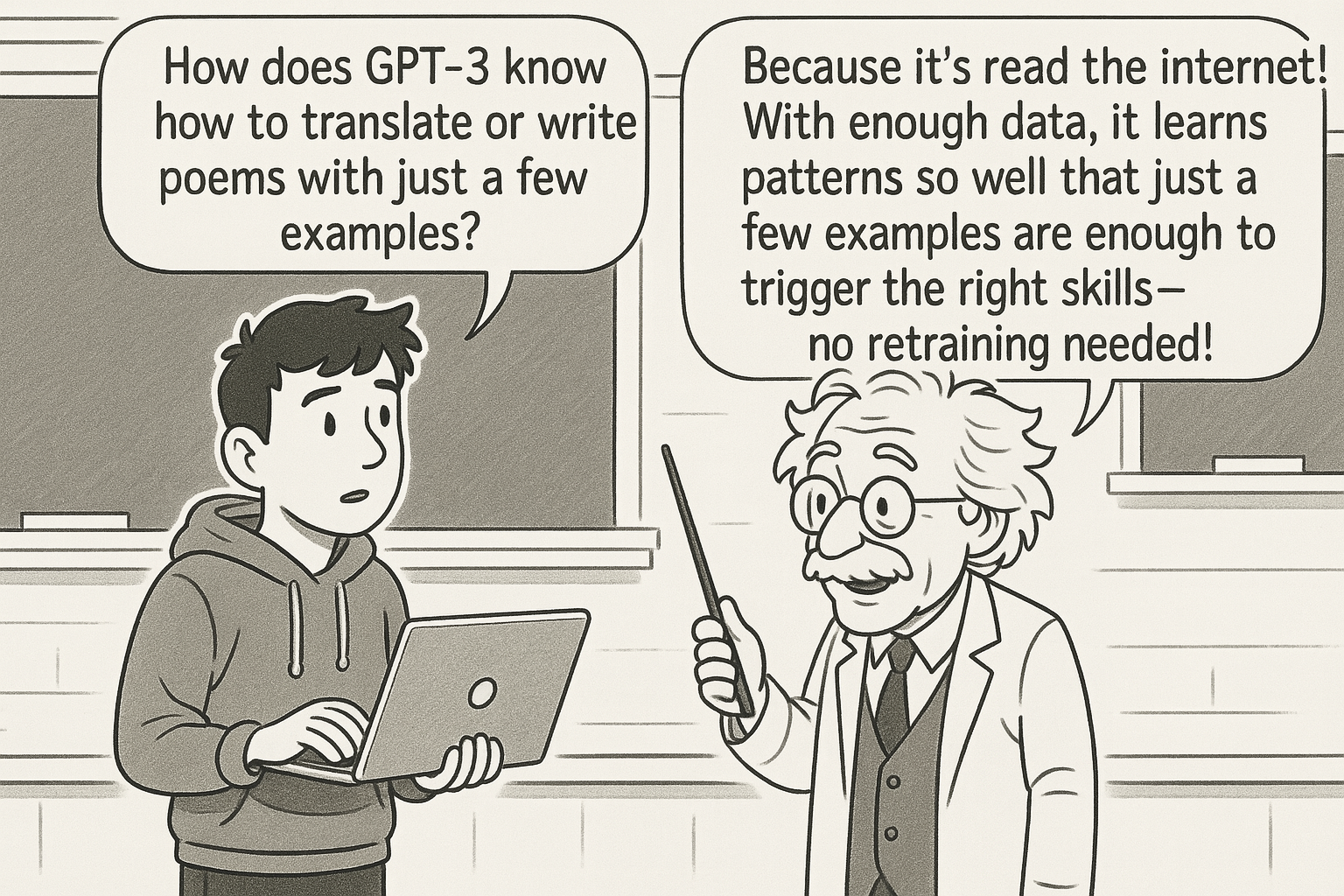Introduction
In 2020, researchers at OpenAI published "Language Models are Few-Shot Learners," introducing GPT-3, a massive 175-billion-parameter language model that fundamentally changed how we think about artificial intelligence. This paper demonstrated that when language models become sufficiently large and are trained on diverse datasets, they develop remarkable emergent capabilities - the ability to perform tasks they were never explicitly taught, simply by being shown a few examples.
Core Ideas
The paper's central breakthrough was demonstrating the power of few-shot learning in language models. Unlike traditional machine learning approaches that require extensive fine-tuning for each specific task, GPT-3 could perform various tasks - from translation to arithmetic to creative writing - just by being given a few examples in its input prompt.
GPT-3 is built on the Transformer architecture, the same foundation as its predecessors GPT and GPT-2, but scaled dramatically. The model contains 175 billion parameters, making it 100 times larger than GPT-2. This massive scale wasn't just about showing off computational power - it was a deliberate test of the scaling hypothesis, which suggests that many AI capabilities emerge naturally as models get larger and training data increases.
The researchers trained GPT-3 on a diverse dataset comprising web pages, books, and other text sources, totalling hundreds of billions of words. Rather than training separate models for different tasks, they created one general-purpose model that could adapt to various challenges through in-context learning - essentially learning from the context provided in the prompt itself.
The paper distinguished between different types of learning approaches. Zero-shot learning means the model performs a task with no examples, just a description. One-shot learning provides exactly one example, while few-shot learning gives a handful of examples. GPT-3 showed impressive performance across all these scenarios, often matching or exceeding specialised models that were explicitly trained for specific tasks.
"Scale in language models unlocks general intelligence through pattern recognition rather than explicit programming."
Breaking Down the Key Concepts
Think of few-shot learning like teaching a very smart student who has read extensively but hasn't studied specific subjects formally. You show them a few examples of French-to-English translation, and suddenly they can translate other French sentences reasonably well, not because they learned French grammar rules, but because they've absorbed enough patterns from their vast reading to recognise and apply similar structures.
The scaling hypothesis is like discovering that a small kitchen can only make simple meals, but a massive kitchen with more ingredients, tools, and space can suddenly prepare complex cuisines it was never specifically taught. GPT-3's size allowed it to develop internal representations rich enough to handle diverse tasks without explicit programming for each one.
In-context learning works differently from traditional programming. Instead of writing specific code for each task, you provide examples within the prompt itself. It's like having a conversation where you establish the pattern through examples, and the model continues following that pattern. This approach eliminates the need for costly retraining or fine-tuning for each new application.

Results and Significance
GPT-3's performance was remarkable across numerous tasks. It could write coherent articles, answer reading comprehension questions, perform basic arithmetic, generate code, create poetry, and even engage in philosophical discussions. On many benchmarks, it achieved competitive results with models specifically designed and trained for those tasks.
For developers and tech practitioners, GPT-3 represented a paradigm shift. The model's public API democratised access to advanced AI capabilities. Suddenly, developers could build sophisticated applications without needing deep machine learning expertise or computational resources to train their own models. This led to an explosion of AI-powered applications - from content generation tools to coding assistants to customer service chatbots.
The paper demonstrated that language models could serve as general-purpose computers, capable of following instructions and performing computations through natural language interfaces. This insight paved the way for the development of even larger models like GPT-4 and practical applications like ChatGPT, which have since transformed how we interact with AI systems.
GPT-3's success validated the scaling hypothesis and encouraged further investment in larger models and datasets. It showed that rather than building narrow AI systems for specific tasks, researchers could focus on creating increasingly powerful general-purpose models that develop capabilities naturally through scale.
Original paper can be seen here - https://arxiv.org/abs/2005.14165